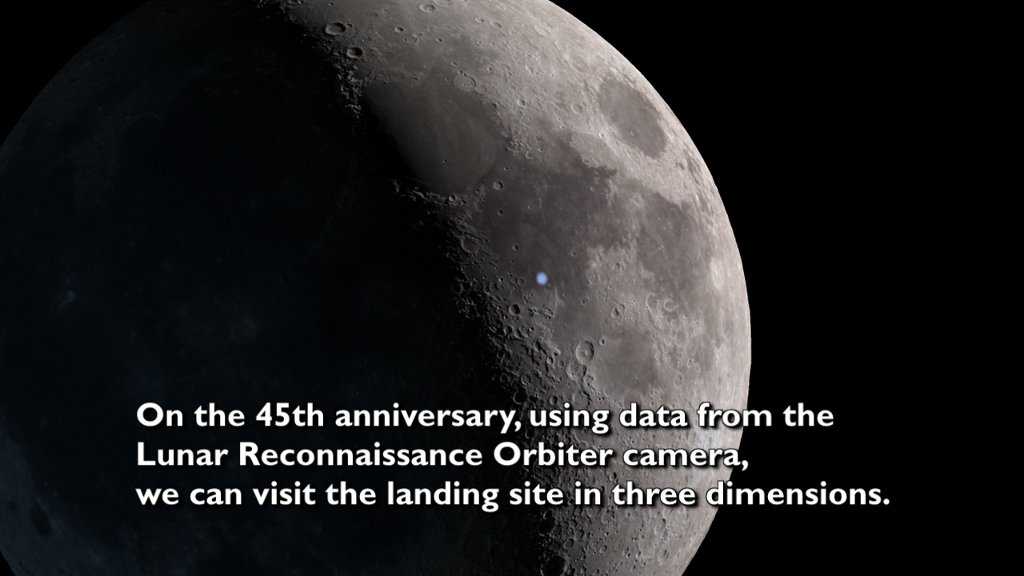Hyperwall: Scouting the Apollo 11 Landing Site

This sequence of images from Apollo 10 looks west across southern Mare Tranquillitatis. The Apollo 11 landing site is circled in green. The bright crater at about 7 o'clock within the circle is West crater. Black and white, 70mm magazine R, AS10-31-4607 to 11.
Prior to the historic Apollo 11 Moon landing, the proposed landing site was surveyed by both robotic spacecraft and astronaut photographers. Images from Ranger, Lunar Orbiter, and Apollo 8 and 10 were all used to search for the best site for the first landing. The safest sites are those that are flat and smooth, with no large boulders and an unobstructed approach path.
The earliest close-ups were taken by Ranger 8 in 1965. The Ranger spacecraft were equipped with multiple video cameras that sent back still images every few seconds. The Rangers didn't orbit the Moon. They were instead designed to impact the surface. This allowed the cameras to take extreme close-ups in the final few seconds before impact.
The Lunar Orbiter program comprised five spacecraft, all of which took pictures from orbit. To achieve the highest possible resolution with the technology of the time, the cameras recorded images onto 70 mm film that was automatically developed onboard. The developed film was then scanned in strips by a video camera that transmitted the image, one strip at a time, back to Earth.
Lunar Orbiter used Kodak Bimat Transfer Film, similar to Polaroid instant film. The splotchy streaks visible in some Orbiter images are the result of the Bimat webbing sticking to the emulsion as it was peeled away, which tended to happen when the Bimat material was left in contact with the film for too long.
The images here can be found at the following locations.
- Apollo 10 Image Library of the Apollo Flight Journal
- Ranger 8 Camera B at the Lunar and Planetary Institute
- Lunar Orbiter Photo Gallery at LPI
- Apollo photographs at the National Archives
- Lunar Reconnaissance Orbiter Camera

Color photograph from Apollo 10, looking northwest within Mare Tranquillitatis. The Apollo 11 landing site is circled in green. The well-defined crater at about 4 o'clock just outside the circle is West crater. Image AS10-34-5158.

This overhead image from Lunar Orbiter V is possibly the best pre-landing image of the Apollo 11 landing site, circled in green. The small crater at 3 o'clock within the circle is Little West, which Neil Armstrong walked to during his time on the surface. The well-defined crater about three circle-widths to the right is West. Ejecta from West comprised the boulder field the astronauts avoided during the landing. Image 76 H3.

Lunar Orbiter V oblique views of Mare Tranquillitatis. The Apollo 11 landing site is circled in green. West crater is just outside the circle at 7 o'clock in the high-resolution image on the right. Image 64 medium and H3.

This sequence of images was taken at 10-second intervals by Ranger 8 as it plunged toward a crash landing in Mare Tranquillitatis. The Apollo 11 landing site is within the green circle. The lighter color pixels in the center are West crater and its ejecta. Camera B, images 56 to 64.

The image on the left was taken by Ranger 8 about 25 seconds before it impacted. It shows an area of Mare Tranquillitatis about two degrees north of the Apollo 11 landing site. The LROC image on the right shows the same area. Ranger 8 image B86, LROC image M1111649357LC.
Credits
Please give credit for this item to:
NASA's Scientific Visualization Studio
-
Image processing
-
Ernie Wright
(USRA)
-
Ernie Wright
(USRA)
-
Technical support
- Laurence Schuler (ADNET Systems, Inc.)
- Ian Jones (ADNET Systems, Inc.)
-
Scientist
-
Noah Petro
(NASA/GSFC)
-
Noah Petro
(NASA/GSFC)
Datasets used
-
NAC (Narrow Angle Camera) [LRO: LROC]
ID: 652
Note: While we identify the data sets used on this page, we do not store any further details, nor the data sets themselves on our site.
Release date
This page was originally published on Thursday, April 4, 2019.
This page was last updated on Sunday, January 5, 2025 at 12:09 AM EST.
